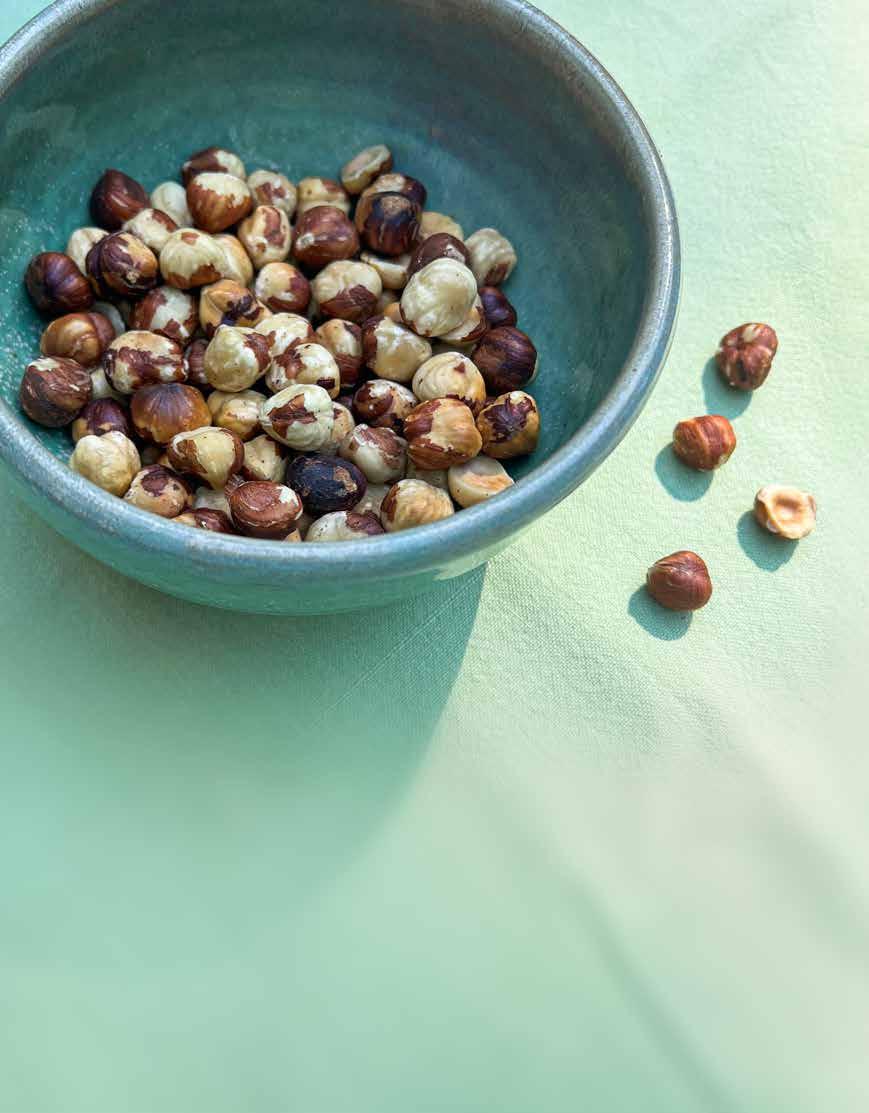
3 minute read
Hazelnuts: A Local Superfood
The hazelnut always seemed somewhat exotic to me—perhaps because of the many European candies I had as a kid that featured them or the fact that they were only found in the fancy mixed nuts—but this delicious tree nut is actually local to our region and totally accessible to the home gardener or cook. Also known as filberts, hazelnuts can be grown in your own backyard and make a wonderful addition to your fall kitchen.
Hazelnuts are the fruit of the hazel tree, with varieties native to North America, Europe and other regions around the world. The majority of the world's hazelnuts are grown in Turkey and Italy, with about 4 percent grown in the Upper Midwest, including Wisconsin. There are wild varieties in the U.S., though the majority of hazelnuts consumed are of the cultivated varieties. Those found around here are large shrubs rather than trees. The hazelnut is typically considered easi- er to harvest than some other nuts, as its hard exterior is shed when the nut is ripe in the fall, around September or October. There is still shelling involved, but less effort goes into picking and husking. New plants need three to four years to begin producing nuts and healthy plants can last for decades, giving the grower an ample supply of hazelnuts over the tree's lifetime. The perennial shrubs send up suckers so they are self-propagating, though it is encouraged to plant multiple trees to ensure cross-pollination, which may help produce a higher yield of nuts. Besides use as part of your garden or food forest, the shrubs can be used as a windbreak and were traditionally used as hedgerows and boundary markers in Europe.
Advertisement
There is hope of growing the hazelnut industry in the Upper Midwest, especially as the plants can be part of regenerative food production. The emerging hazelnut industry in our region has a lot of potential, with growers and researchers looking to find the best, most profitable hazelnut varieties to make this a viable crop for our area. The Upper Midwest Hazelnuts Initiative, a collaboration between the University of Wisconsin–Madison and University of Minnesota, is one group working on such endeavors. They are also looking to promote growing and using hazelnuts as part of a sustainable food system. Commercial hazelnuts are typically grown in monocultures (imagine a huge field of nothing but hazel trees), but small-scale growers are beginning to incorporate hazel trees as part of permaculture farms and gardens where they can be planted alongside other fruit or nut trees, culinary and medicinal herbs, as well as among cover crops like legumes and clover. Animals such as pigs can be incorporated as well. Pigs can be raised on the same land as hazel trees because they love to eat the windfalls while offering fertility to the soil through their waste.
The nutrition of hazelnuts is quite similar to other nuts, in that they offer fiber, monounsaturated fats, antioxidants like vitamin E and polyphenols, and small amounts of protein. My favorite nutritional aspect of nuts, including hazelnuts, is the mineral content, which gives us magnesium, manganese, selenium and copper. I always recommend soaking or sprouting nuts, as well as cooking them in some way (such as toasting) before consuming. This improves their digestibility and nutrient bioavailability, decreasing the content of anti-nutrients like phytates and making them more nutritious. To soak nuts before using, simply cover your desired amount of nuts with water in a bowl, adding a pinch of salt. Let this sit for approximately 24 hours. Drain off the water, then spread on a sheet pan. Roast the nuts at 325 F for about 25 minutes, or until completely dried. You can roast longer to toast them if preferred, which brings out their rich, sweet flavor even more.
Whether you are going to be growing hazelnuts or not, eating them is a no-brainer. Hazelnuts are delicious by themselves, especially when salted and lightly toasted. Many are familiar with these in fancy mixed nuts or the tastiest spoonful on earth, chocolate hazelnut spread, but they are equally wonderful when used in other recipes. Hazelnuts can be used like most other nuts in recipes, both sweet and savory, though I find their flavor to be a particularly delightful and unique addition to homemade granola, muffins, scones, on top of salads, or anywhere else you need a bit of crunch and flavor. They can be added to sauces like pesto in lieu of pine nuts or made into homemade nut butter. Hazelnuts, of course, are especially delicious when paired with chocolate, in the case of Nutella® (a chocolate hazelnut spread) or other chocolate hazelnut sweets. Magpie Gelato in Viroqua often features a bacio flavor, a chocolate hazelnut gelato that is to die for. Hazelnuts can be dried and ground into a flour which can be used for gluten-free baking, much like almond flour but with more flavor. Hazelnut oil, a total flavor bomb, works great in salad dressings and in baking as well. Locally-grown hazelnuts and hazelnut products from the American Hazelnut Company in Gays Mills are a great example of small-scale producers getting this regional food into the marketplace. While we usually think of meats, dairy and produce when choosing locally grown foods, nuts are certainly part of our local food landscape as well, with hazelnuts as a perfect, delectable example (see, Wisconsin can be fancy, too!).









